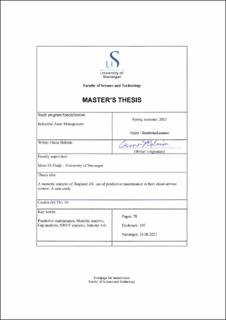| dc.description.abstract | As the fourth industrial revolution is gaining traction in most industries, with digitization, predictive maintenance (PdM), artificial intelligence, and cyber-physical systems it is important for most of the companies that want to be market-leading to be a part of the revolution commonly known as industry 4.0. The shipping industry is no exception and is also undergoing changes with the adaption of industry 4.0. Industrial sectors that depend heavily on physical assets, e.g. manufacturing and transportation industries, have a special interest in PdM in order to maintain reliable, safe, and available assets. Therefore, we are eager to gain the benefits from adopting predictive maintenance.
However, there are several challenges to implement PdM into existing industrial installations and commercial solutions:(1) lack of standards, (2) lack of maturity modes, (3) lack of commercial reliable products and services. For example, Høglund AS provides cloud services for the shipping sector and aims to adopt PdM to provide more intelligent and cognitive tools for their customers. To do this they would like to assess the maturity of its services in combination with the physical assets of the customer and determine what should be considered to reach a higher level of cloud services.
Therefore, the purpose of this thesis is to assess the current maturity level of Høglund AS and work out what needs to be improved in their systems to reach a high level of PdM maturity so their cloud service system can be used for predictive maintenance.
To be able to fulfill the purpose, Høglund was purposefully selected as a case study for this thesis, and the case study research method was applied. Through this thesis, five types of analysis were applied: (1) system of systems (SOS), (2) Needs and requirement analysis, (3) Maturity analysis, (4) Gap analysis, and (5) SWOT analysis.
To conduct the five analysis methods as stated above, data was required. The data was collected by the use of several methods. First, research in the existing system that Høglund is operating was carried out. Semi-structured interviews with the main stakeholders of the system were conducted. This was followed by a questionnaire about the current state of the system that was given to both Høglund and its customers. Last, diesel engine reliability data was obtained. All the collected data was concentrated and used for further analysis. The results from some of the analysis methods also served the purpose of data for the next analysis method.
The key results and findings of the analysis are as follows:
1. Cloud service providers like Høglund has to build customized maturity model, as the general maturity models (e.g. the one developed by PwC) have limitations when it comes to detailed specifications.
2. The maturity model for cyber-physical systems requires considering both the cloud service provider and their customer. It is clear from the results that a combined maturity model provides higher maturity levels.
3. Cloud service providers shall focus on full sensorization and data collection to support the analytics of interest. This should be based on the prioritization table that can be derived from the Gap analysis.
4. Cloud service providers shall consider Gap and SWOT analysis to connect the maturity studies and findings with strategic planning.
5. Maturity studies shall be utilized to support the decision-making process and it shall be part of the continuous improvement processes.
All in all, Høglund has a lot of the necessary infrastructure to offer PdM to their customers. However, they are underdeveloped in certain areas, like the data they collect and the missing data analysis. The overall maturity level Høglund obtain at the moment is 3 out of 4. By allocating resources to develop their cloud service system further, they will most likely reach a level 4 if they want to. | |
